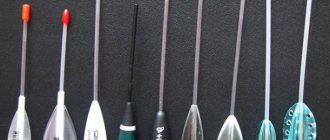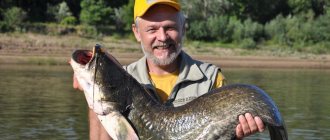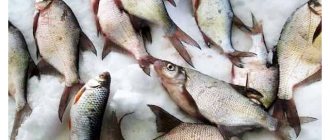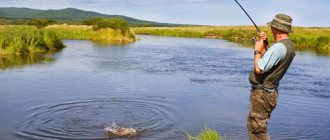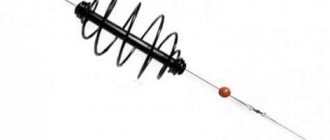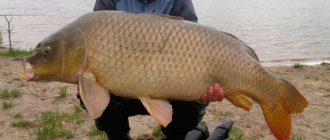Gear device
Bombarding for grayling is an alternative to fly fishing, allowing you to fish with dry and wet flies, as well as other light baits, with a simple spinning or feeder rod. Long casting helps to make the same float - bombard or sbirulino. In general, the tackle consists of the following elements:
- Rod. Here they use a long spinning rod of 2.7-3 meters, a medium feeder and even, in some cases, a four-meter lap dog. The bait test form must correspond to the weight of the bombard together with the rest of the load: fittings and bait.
- Coil. An inertia-free spool with a spool capable of holding 100-150 meters of fishing line. A high-quality friction clutch is the main condition for choosing a “meat grinder”.
- Fishing line. Since fishing is done at a long distance, the best option would be to use thin braid in combination with a shock leader, a piece of monofilament more than two rods long. The leader will allow you to throw heavier bombards, resist abrasion in strong places, and take on the load during forced fishing. In addition, it is easier to install equipment on nylon than on wicker.
- Bombard. A special float with an antenna and body, most often transparent. Depending on the fishing conditions, choose a sinking, neutral or floating sbirulino model.
- Accessories. Mandatory elements in the construction of gear are swivels and dampers - soft silicone stoppers.
- Leash. Made from thin braid or monofilament, depending on the fishing conditions, its length ranges from 50 centimeters to one and a half meters.
- Bait. Artificial bait or natural bait on a single hook.
The gear is assembled in the following sequence:
- A reel is placed on the selected fishing rod and equipped with the main fishing line - a braid of 0.10-0.14 millimeters.
- A shock leader - a monofilament with a diameter of 0.2-0.25 millimeters - is attached to the braid with a double sliding knot.
- A silicone stopper is mounted on the leader.
- Then the line is threaded through the bombard, so that the antenna is at the top, closer to the rod.
- After the sbirulino, a second stopper is placed to protect the swivel attachment point.
- A swivel is attached.
- A leash with bait is attached.
Fishing technique and tactics
The choice of bombard type and bait placement technique depends on the strength of the current in a particular body of water. If fishing takes place on a lake, then the usual fan casting of bait is used. If we are fishing on a river, we must first of all focus on the strength of the flow.
Fishing in still water
Fishing is easiest on a lake or similar body of water. The choice of a specific bombard depends on the grayling sites at a particular time of year.
In summer, when insects are active, use a dry fly or a popper with a floating bombard. To catch grayling in the fall, when the fish go deeper, neutral and then sinking models are used.
Slow current
The slow current allows for a variety of casts, almost like on a lake. But still, the best animation technique occurs when casting the fly downstream. First, we float the bait down as far as fishing conditions allow.
Then we begin to slowly pull it towards us, accompanying the rotation of the reel with small twitches of the rod tip. A bite can occur both on the raft and on the animation towards you, so you need to be careful. The choice of bombard type also depends on the grayling sites.
Lures
Grayling can be caught using both artificial and natural baits. Below we list all possible options. Natural baits used:
- worms;
- maggots;
- bloodworms;
- caddisfly larvae;
- insects by season;
- fry of local fish.
Sometimes fishing for grayling is successful using vegetarian baits, such as:
Of the artificial baits, we note the following:
- fly fishing flies;
- poppers;
- minnow;
- small cranks;
- small silicone;
- micro spinner.
The choice of bait depends on the preferences of both the fisherman and the fish. In addition to your own preferences, you need to take into account what the grayling in a particular body of water currently eats. Then fishing will become unforgettable in terms of impressions and catchy in terms of results!
Bombard rig for grayling fishing
The most important thing in such gear is the bombard itself. A bombard is a special type of float that allows you to cast bait over long distances. They come in different sizes, and there are also floating and sinking ones.
You also need to carefully choose a fishing rod for such gear. If you take a lighter rod and a heavy float, then when casting you will simply break it. For this reason, it is important to choose a rod according to the parameters of the bombard.
The length of the rod also depends; the best length for such gear is three meters. If you take a shorter one, then most likely you will not be satisfied with such tackle due to the difficulty of casting.
Methods for catching grayling with a bombard
There are many ways to catch grayling using a bombard. But generally experienced scorers use three methods of casting. The first of them is along the current. The bombard is suitable for fishing for grayling both in autumn and summer; it is cast as far downstream as possible, and then the retrieval begins, pulling all the equipment towards it.
The second method of casting is carried out as follows. The bombard is thrown across the current. The line is then tensioned and held at the same tension. The bombard is carried downstream and the float with baits seems to describe an arc along the river, approaching the shore.
Well, the third way is to throw the tackle upstream of the river. When the float falls into the water and begins to float, the line is wound onto the spool at such a speed that the line does not sag in the water.
Rating of the best flies for grayling
It is impossible to create a single rating that would be equally fair, since any fly may not work in a body of water. The correct way to determine the best fly for grayling fishing is to evaluate its suitability for natural food in a particular season.
Read more
How to catch dace in the spring with a float rod?
Rating of the best flies for grayling
Which fly is best to attach to a fishing line:
- Many experienced anglers agree that the best fly is a caddis fly imitation. This variety is applicable on mountain rivers and is successfully used on Karelian lakes. It performs well throughout the season, since caddisfly is included in the diet of grayling throughout almost the entire year. Even with its small dimensions, the caddisfly copy plays well on the water and accurately replicates the movements of insects;
- mayflies show the best results in spring, but it is important to catch the flight of these butterflies. Wiring fishing is possible and proves catchy in almost any weather conditions. Bycatch is small taimen and whitefish;
- The nymph is most attractive in the summer. Now grayling swims in the water column, less often sinks to the bottom, sinking equipment leads to aggressive and confident bites. Additionally, the nymph is good in autumn fishing before the onset of freeze-up;
- universal bait - bunting larva. Its imitation causes bites throughout the season. If we use a classic fly, it also catches trout, whitefish, ide, and chebak. The only difficulty with the bait is the need to select the correct color for each season;
- Caddisfly pupa often leads to the capture of trophy specimens. We use it as a bait on float rods, lowering the bait through the water. Usually bites come at the last moment: on a riffle or in a still pool.
Bombard fishing time
Catching grayling with a bombard begins as the air warms and insects fly out; you also need to take into account the fact that the water is sufficiently light after ice drift. By the time the water becomes suitable for fishing, the grayling will have already spawned and will have gained all its weight, so that in the first weeks of summer its feeding is especially active.
Most often, he stands on a current where there are underwater obstacles that form curls, and you can find a trophy in them. Another favorite place for grayling to stop is on rapids; the fish stands either a little higher or a little lower. You can catch grayling in the summer using a bombard both from the shore and across a ford; it won’t scare this cautious fish.
Most anglers prefer to fish in a ford; this increases the area where they can throw gear to catch the desired fish. If you decide to go fishing when the weather is sunny and warm, then it is best to do it in the morning or in the late afternoon at this time the bite is more active, and in cloudy weather the grayling bites all day long.
To the bombard
Usually schools of garfish are clearly visible even from the shore. When this fish is actively hunting, it often even jumps out of the water in pursuit of the fry. First of all, the tackle is assembled, but the leash does not cling, only the bombard. Then the first cast is made without bait.
This is necessary in order to wet the fishing line and rings. In the future, there will be less friction, which means casting further. In order to better wet the line, the rod is lowered down, ensuring that the line lies on the water.
It is better to make long casts, at a distance that is allowed by the capabilities of the equipment and the skill of the fisherman. Wiring the bait for catching garfish should not differ in any intricacies - simple, uniform, and at an average speed. The bite of a garfish is almost always felt very well, as it attacks the prey quickly.
If you feel a tug or tug, you should immediately hook the garfish. If a braided cord is used, then a small movement of the hand is enough, but with a fishing line, the movement should be with a greater amplitude.
Fishing for garfish must be quick and decisive. Usually he actively resists and even jumps out of the water, making a candle. Naturally, this brings a lot of pleasure to the fisherman. Garfish often swallow the bait very deeply, so you need to have an extractor with you, and sometimes you have to cut the leader. That’s why you need to have a supply of them with you.
Results:
- Fishing for garfish with a bombard is a modern sporting and active method of fishing that brings a lot of fun.
- For different fishing conditions, you need to have bombards of different weights with you when fishing.
- It is imperative to prepare in advance a supply of leashes, which sometimes have to be sacrificed while fishing.
- To catch garfish, it is better to use a braided line, and as the fisherman’s skill increases, reduce its diameter down to 0.1 mm. With a thin cord, your casting distance will significantly increase.
Lures for catching grayling with a bombard
Depending on how you plan to catch grayling in the fall or summer, on the surface of the water or in the depths, you also have to choose which fly to put on. For surface fishing, dry flies are used, those that float, and for fishing in the water column, they take either a wet fly or a nymph. Flies made from badger hair have proven themselves to be the best.
Taking into account the fact that grayling is a very cautious fish, flies should be as similar as possible to real insects. If the fish doesn’t like the fly or suspects something is wrong, then there won’t be a bite.
Fishing for trout with a bombard
Fishing for trout on paid platforms
Fishing for trout with a bombard is very important when the fish stands at a fairly large distance from the shore, as a result of which it is problematic to send a light rotating spoon or twister to such a distance.
What is a bombard?
In appearance, the bombard resembles a float. It has a spindle-shaped body through which an antenna passes with a special hole for fishing line. As a rule, the base of the bombard is made of balsa; cheaper options are made of plastic. Fishing for trout on paid platforms is carried out using a transparent bombard, which is practically invisible in the water. Inside the body of the bombard there is a weight made of brass or lead, the location of which determines its classification. There are five official varieties of this tackle.
The classic bombard is lowered into the water column in a strictly vertical position, due to the load concentrated in its lower part. If it is necessary to fish near the bottom or in the middle layers of water, use a bombard with a load distributed along the entire length of the body. To obtain more sensitive equipment, use a bombard with a load that is concentrated at the center of gravity of its body. For horizontal wiring, a bombard with an extended weight at the head of the float is better suited. The most sensitive are those bombards, the weight of which is located at the edges, which gives them a horizontal position in the water. Also, based on the weight of the cargo, bombards are divided into floating, slow and fast-sinking.
Fishing rod for trout using a bombard
Having decided on the choice of bombard, you can move on to selecting the remaining parts of the tackle. For more convenient casting, it is best to use a rod whose length varies from three to five meters. The material from which it is made is not particularly important, and for the most part depends on the finances available to the fisherman. When choosing a fishing line, it is necessary to take into account the characteristics of the reservoir, but it is better to use a braided cord or fluorocarbon fishing line. When fishing for trout, the leash is a one and a half meter piece of high-quality fishing line with a diameter of up to two tenths of a millimeter. It is better to use hooks from well-known companies, as they are made of thinner wire and dig into the fish more easily.
Fishing for trout with a spinning rod using a bombard has several points that should be written about. Very often, the line gets twisted during wiring, so you need to use swivels. To prevent the leash from getting tangled when casting, it is necessary, a second before the tackle falls to the surface of the water, to stop it using the reel stopper, thus straightening the tackle into one line.
Lures and methods of catching trout with a bombard
Using a bombard, trout can be caught using both natural and artificial bait. Almost the entire range of baits that can be found on store shelves can be used for bombard fishing. For example, trout fishing in the fall can be done using various types of wobblers or small rotating spoons. In this case, you should choose a bombard that will allow you to move the bait near the very bottom or in the water column.
One of the most important advantages of trout fishing with a bombard is its ability to cast bait at almost any depth, which greatly facilitates the search for fish in a given area of the reservoir. By promptly changing bombards of different classifications, you can quickly determine at what depth the fish are standing and immediately begin catching them.
Trout fishing with a bombard is a new and very exciting activity that allows you to successfully catch fish over long distances with minimal effort and time.
Fishing rod rig for catching grayling with a bombard
Tackle for catching grayling with a bombard must include such mandatory elements as:
- Rod. It is selected taking into account long-distance casting; it is optimal to choose 3-6-meter rods. Depending on the weight of the sbirulino, the test is selected; as a rule, it ranges from 40 to 60 grams.
- Coil. It is more effective to choose spinning reels, and up to 100 meters of 0.25 mm fishing line should fit on it.
- Fishing line. You can use monofilament and braided fishing line. Thanks to their ability to stretch, braided lines are great for long-distance fishing. For close-range fishing, it is better to choose a monofilament line that can dampen the jerks of the caught fish.
- Bombarda or sbirulino. Selected depending on the fishing distance. The optimal weight of the equipment is considered to be up to 40 grams.
- Leash. The choice of leash is determined by the type of fish you are going to catch. Often a small piece of fluorocarbon line is used.
- Swivel. Using size 14 to 20 swivels helps reduce the chance of bombard line twist, which is often seen with spinners and flies.
- Hooks. You should choose strong and sharp hooks. When using bait of animal origin, it is better to choose long hooks with a wide hook and a small barb. The size of the hook is determined by the size of the bait and the type of fish being caught.
Varieties of flies for catching grayling
Taking into account the peculiarities of grayling fishing, initially everyone began to actively hunt for various insects, but were faced with the problem of storing bait. Not all insects tolerate being stored for several hours well. A good solution to the problem was to get bait directly at the fishing spot, but another difficulty arises - it is difficult to start fishing before dawn, since it is difficult to catch bait at night.
Read more
What tackle to choose for grayling?
Artificial flies for catching grayling do not have these disadvantages and also have additional advantages:
- universal in use;
- manufactured in suitable size and weight;
- are firmly fixed on the hook, the nozzle will not slip during casting;
- have durability;
- if made by hand, all materials are cheap.
We recommend using exclusively hand-made flies for catching grayling, since the predator tends to tightly grab the bait, making its further removal problematic.
In total, there are two main groups of flies designed for different fishing methods and seasons.
Artificial flies for grayling fishing are durable and versatile in use
What flies are needed for catching grayling:
- dry, high. Designed to imitate insects blown into a pond by the wind or fallen from above-water vegetation. In appearance they resemble wasps, dragonflies, butterflies, flies, and various moths. A characteristic feature of dry flies is the use of a fluffy body. Usually, during the manufacture of flies, bird plumage and animal fur are used. We recommend using small hooks; it is better to buy them to ensure structural strength, but homemade options are also suitable;
- wet, cargo. Also interesting are cargo flies for catching grayling, which are distinguished by imitation of various aquatic insects, nymphs, pupa, tadpoles, caddis flies and other small things floating on the surface of the water. When installing the equipment, we use a minimum of feathering and fluff, and we use relatively thick and large hooks. Additionally, we can use thick wire weights.
It is important to understand the behavior of grayling depending on the season in order to choose the right bait:
- we imitate the insects that are most numerous in a particular season. In the spring, it makes no sense to use insect species that emerge in late summer. Rare species are also not needed, since grayling may be frightened by the sight of an unfamiliar bait;
- catching grayling with a high fly is more effective in the warm season (May and summer), since in early spring it lives in the bottom layers of water. The reason for this behavior is the lack of food on the surface of the water. In spring, it is better to use imitation worms, river mollusks, eggs, caddis flies, small crustaceans, caddis flies;
To choose the right bait, it is important to understand the behavioral characteristics of the fish.
- in April and early May, fishing methods using a bombard with sinking flies are more effective. On almost all bodies of water, variants that imitate the mayfly butterfly (flying out in the middle or end of May) are popular. We can produce it in both riding and sinking types. If the time of year is chosen incorrectly, the predator will not be tempted by this bait;
- When selecting equipment, current should be taken into account. In reservoirs with a fast flow of water, the riding fly should not go astray; an option is made that most accurately imitates natural baits;
- In summer it is better to go out for grayling on small rivers and pools on rifts, where it goes well for flies, butterflies, amphipods and ants.
We recommend attaching 3-6 leashes to the main line at the same time, attaching different flies to each. This kind of acquaintance with the reservoir is the fastest and most successful; you will be able to immediately identify catchy and useless baits.
Methods for catching grayling with a bombard
You can catch grayling using a bombard in different ways, of which there are a huge number, but the most commonly used are the following:
- along the current - the bombard is thrown downstream, and then all the equipment is pulled towards itself;
- across the current - the sbirulino is thrown across the current, while the fishing line is stretched, and the tackle with bait is carried closer to the shore, describing an arc;
- upstream - cast upstream of the river, when the float hits the water, the fishing line is reeled in so that it does not sag.
When fishing for grayling with a bombard, use a 4-5-meter rod with guides and a weight of 30-40 grams; it is better to choose a spinning reel with a line up to 0.19 mm.
How to catch grayling using a bombard
So, let's get acquainted with some rules for catching grayling with a bombard. The casting of the tackle is done a little higher than the place where the fish are supposed to stay, because grayling is not in vain considered one of the most sedentary fish. The bait must be placed near the bottom - large grayling will not rise to the surface of the water even for its favorite delicacy - insects. This fish is a hunter and gatherer. The grayling waits for the prey to come into its field of vision, and then it’s a matter of technique: a swift throw, a grab, and a return to its place. That is why the line must be constantly taut, this will allow you to make a hook at any time. This method will be most effective on straight sections of reservoirs with a smooth flow. Grayling is an omnivorous fish. It usually feeds on the larvae of various bottom organisms or insects that accidentally fall into the water. You can catch grayling using both natural baits (worms, caddis flies) and artificial ones. Experienced fishermen prefer the latter. After all, artificial flies are durable, you can not only buy them in specialized stores, but also make them yourself. If the angler finds the right bait and presents it properly, the grayling will definitely not resist and bite.
To be continued, “Where and when to catch grayling with a bombard” in the next article
Lures for catching grayling with a bombard
The choice of fly for grayling depends on the fishing method - on the surface of the water or under water, as well as on the time of year. Surface fishing requires the use of dry flies that are able to float on the water, and underwater fishing is carried out with a wet fly. Badger hair is an excellent material for bait.
At different times of the year, fish prefer certain foods. To select the optimal bait, you should choose either natural bait or its imitation.
To catch grayling, different types of bait are used:
- Animals - maggots, bloodworms, worms, larvae, various flying insects, adults are excellently caught with fry or frogs.
- Vegetable - bread, different types of dough, grains of corn, peas or pearl barley.
- Artificial ones - silicone fish, small spinners, wobblers, flies and foam balls have proven themselves to be excellent.
